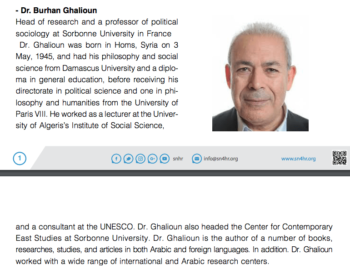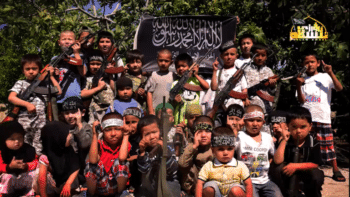This is part one in an investigation into government-funded, opposition-linked NGOs that pose as impartial monitors and investigators of the Syrian conflict.
The Syrian Network for Human Rights (SNHR) portrays itself as a neutral “monitor” of Syria’s bloody war. In recent years, the group has become a go-to source for corporate media outlets.
Major U.S. newspapers, human rights organizations, and even governments have credulously echoed SNHR’s dubious reports. But not once have these institutions questioned what exactly the organization is, who funds it, and what its relationship is to Syria’s armed opposition.
An investigation by The Grayzone reveals that the Syrian Network for Human Rights is far from the impartial arbiter that it has been sold as. In reality, it is a key player in the Syrian opposition. Currently based in Qatar, SNHR is funded by foreign governments and staffed by top opposition leaders.
This “monitoring group” has even openly lobbied for “immediate intervention” in Syria by an “international coalition,” citing NATO’s 1999 bombing of Yugoslavia as a model. These explicit calls for foreign military intervention have been repeated for years by SNHR itself, as well as by the organization’s leaders.
Yet one would never know this side of the SNHR’s activities from corporate media reporting.
An ‘independent monitoring group’ run by the Syrian opposition
On May 11, The New York Times published an exposé claiming to provide new details of a “secret, industrial-scale system of arbitrary arrests and torture prisons” in Syria. Filed from Turkey by reporter Anne Barnard, this article centered around the eyebrow-raising claim that 128,000 people have never emerged from Syrian prisons, “and are presumed to be either dead or still in custody.”
The Times’ source for this shocking statistic was the Syrian Network for Human Rights, which Barnard described as an “independent monitoring group that keeps the most rigorous tally.”
SNHR also supplied key data for a June 2 report by Washington Post reporter Louisa Loveluck on the arrests of Syrian refugees who have returned home. The group insisted that “2,000 people have been detained after returning to Syria during the past two years.”
In the past few years, SNHR has been uncritically cited by major news outlets, from The Guardian to The Intercept to The Daily Beast. Western journalists have unquestioningly regurgitated SNHR data to provide statistical heft to gut-wrenching reports on the Syrian government’s alleged abuses.
Even Amnesty International turned to the group for help on a widely promoted report on Syria’s Sednayah Prison. On its website, SNHR boasts that it was the second-most cited source in the U.S. State Department’s 2018 report on the human rights situation in Syria.
When it is cited in mainstream media, SNHR is almost invariably characterized as a neutral observer without any agenda beyond documenting death and abuse. In Barnard’s article, the group was described as “independent,” absurdly implying that it was not affiliated in any way with governments or individuals that have participated in the Syrian conflict.
While there may be little doubt that the Syrian government presides over a harsh police state apparatus, it has also been the target of one of the most expensive and sophisticated disinformation campaigns in recent history.
Seeking to stimulate support among a war-weary Western public for U.S. military intervention, a collection of billionaires and foreign governments has leveraged hundreds of millions of dollars into a high-tech information war waged by NGOs, insurgent-linked civil society groups, and mainstream corporate media.

Ghalioun’s bio at SNHR’s website (above) fails to acknowledge his role as a leader of the opposition SNC
The Syrian Network for Human Rights has emerged as one of the most important cogs in this operation. Posing as a professional human rights organization, SNHR has functioned as a publicity arm of the Syrian opposition, operating out of Doha, Qatar and collaborating with the opposition’s “embassy” there under the direction of Syrian opposition leaders.
On SNHR’s board of directors sits Burhan Ghalioun, the longtime leader of the Western-and Gulf-backed Syrian National Council, which was founded as an opposition government-in-exile.
The Syrian Network for Human Rights has a reputation for warping numbers to support its ulterior regime change agenda, while relentlessly downplaying the crimes of Salafi-jihadist militias, including ISIS and al-Qaeda’s local affiliate, Jabhat al-Nusra.
What’s more, the group’s leadership has openly clamored for Western military intervention, most recently after it issued a dubious report in May on alleged Syrian government chemical attacks that turned out to be sourced to an al-Qaeda affiliate comprised entirely of foreign fighters.
In a report on its website, SNHR acknowledges that it is “funded by states,” though it does not disclose which ones those are.
Given the ideological composition of its leadership and their basing in Qatar, it is easy to deduce that those government funders are the same ones that have bankrolled an Islamist insurgency in Syria to the tune of several billion dollars, costing many thousands of lives and helping to fuel a refugee crisis of titanic proportions.
The Syrian Network for Human Rights (@SNHR) is totally nontransparent, but quietly admitted it is funded by "states" https://t.co/T2yFTpxXAx pic.twitter.com/PqWRBQbRKX
— Ben Norton (@BenjaminNorton) September 25, 2017
So why have so many journalists who depended on SNHR omitted vital context like this while attempting to pass the group off as “independent”? Perhaps because providing readers with the full truth about the organization would raise questions in their minds about its credibility–or lack thereof–and expose yet another journalistic narrative designed to trigger Western military intervention.
Citing the Syrian Network for Human Rights as an independent and credible source is the journalistic equivalent of sourcing statistics on head trauma to a research front created by the National Football League, or turning to tobacco industry lobbyists for information on the connection between smoking and lung cancer. And yet this has been standard practice among correspondents covering the Syrian conflict.
Indeed, Western press has engaged for years in an insidious sleight of hand, basing reams of shock journalism around claims by a single, highly suspect source that is deeply embedded within the Syrian opposition–and hoped that no one would notice.
Expert: SNHR is ‘more partisan and less objective’ than other pro-opposition monitors
The Syrian Network for Human Rights has spent years systematically whitewashing and downplaying the crimes of ISIS, al-Qaeda, and other extremist groups while inflating the numbers of those killed by government forces.
In a typically slanted report in 2017, SNHR claimed that the Syrian government was responsible for over 92 percent of all deaths during the conflict. Meanwhile, the group reported that “extremist Islamic groups” like ISIS and al-Qaeda’s local franchise were responsible for less than 2 percent of those killed. As usual, the organization provided nothing to back up its absurd numbers other than a cartoon graph.
SNHR’s death tolls stand in stark contrast with those of the Syrian Observatory for Human Rights (SOHR), another widely cited organization dedicated to tracking casualties in the Syrian conflict.
Based in Coventry, England and run by a single pro-opposition figure, Rami Abdulrahman, the SOHR has received funding from the British Foreign Office to monitor deaths in Syria.
But unlike SNHR, SOHR has asserted that the death toll among government forces has been almost equal to that of opposition fighters, with over 60,000 dying to beat back a foreign-backed insurgency.
Even the explicitly pro-opposition, UK-based "monitoring group" SOHR is acknowledging that more than 1/3rd of the people who have been killed in the war in Syria are pro-government forces — roughly equal to the number of rebels who have been killed.https://t.co/oTcJfwApR7 pic.twitter.com/rH4Zq8JG2g
— Ben Norton (@BenjaminNorton) March 12, 2018
Because numbers like these undermine the one-sided narrative fashioned by Western media and NGOs dedicated to regime change, many have turned to SNHR instead for more politically convenient statistics spun out through graphics simple enough for a child to digest.
“SOHR is more reliable than SNHR, which is closely associated with the Syrian opposition,” explained Joshua Landis, professor of international and area studies at the University of Oklahoma and a leading expert on Syrian affairs, in an interview with The Grayzone.
“SOHR is also associated with the opposition, but the head is sympathetic to the Kurdish opposition which perhaps makes him a bit more even handed than either of the main antagonists, who have been known to play fast and loose with the facts,” he said.
Landis emphasized that “SNHR is more partisan and less objective” than the pro-opposition SOHR, adding that “it is impossible to know what the real statistics are for the obvious reasons.”
Indeed, the United Nations stopped tabulating deaths in the Syrian conflict in 2014, citing the difficulty it had in obtaining even remotely accurate numbers.
Another chemical “red line” deception?
Not only has the Syrian Network for Human Rights conjured up ridiculously slanted death toll numbers, it recently made suspicious claims of chemical weapons use by the Syrian government in an overt bid to trigger U.S. military intervention.
On March 27, as Syrian forces closed in on the province of Idlib, the home of the rebranded al-Qaeda affiliate known as Hayat Tahrir al-Sham (HTS), SNHR claimed that the Syrian government used a missile launcher to fire “poison gas” at an HTS position in the eastern suburbs of Latakia. The attack “caused breathing difficulty, redness of the eyes and tearing” among the targets, according to SNHR.
The U.S. State Department seemed to echo the suspicious information reported by SNHR to claim without concrete evidence on March 19 that it had received “indications of any new use of chemical weapons by the regime.”
SOHR issued a report of its own, however, that undercut the claims by SNHR and the U.S. According to SOHR, “the Turkestani [Islamic] party is the source and basis of the news adopted by the United States of America about the shelling by the regime forces using chlorine gas.” The SOHR noted that one Turkestani Islamic Party fighter who claimed to have been attacked by chemical gas had asthma.
The Turkistan Islamic Party (TIP) is comprised largely of Uyghur Muslim militants from China’s Xinjiang region who are allied with HTS in Syria and Al Qaeda on a global level. TIP leadership has called on foreign Muslims to wage jihad in Syria, publishing an online recruitment video in 2018 that celebrated the 9/11 attacks as holy retaliation against a decadent United States awash in homosexuality and sin.

Children of the Turkistan Islamic Party, the apparent source for SNHR and the State Department’s dubious claim of a chemical attack in Idlib
Fadel Abdul Ghani, the chairman of the opposition-linked SNHR, suggested openly in his group’s dubious report of chemical weapons use that his intention was to see the U.S. intervene in support of Islamist extremist militias like HTS and TIP.
“The U.S. president, the French president and the British Prime Minister have threatened the Syrian regime that if chemical weapons are used again, there will be a decisive response,” Abdul Ghani stated. “Syrian society is still waiting for these leaders to fulfill the promises made, and to hold the Syrian regime to account in a serious and effective way.”
Abdul Ghani has openly advocated for U.S. military intervention for years, telling The Atlantic in 2013 that any civilian deaths by American airstrikes were preferable to the preservation of Assad’s rule. “If Assad continues without any intervention, everyday we will keep losing 100 to 120 people,” Abdul Ghany said. “We have no choice. If we don’t try to take out Assad’s missiles and tanks, he will continue using them against civilians.”
In May 2019, SNHR once again made a public call for foreign military intervention, based on dubious claims of a chemical weapons attack.
 On May 27, the ostensible monitoring group published a report subtly entitled “The Syrian Regime Uses Chemical Weapons Again in Latakia and the United States, France, Britain and the Civilized Countries of the World Must Fulfill Their Promises.”
On May 27, the ostensible monitoring group published a report subtly entitled “The Syrian Regime Uses Chemical Weapons Again in Latakia and the United States, France, Britain and the Civilized Countries of the World Must Fulfill Their Promises.”
The intention of the report was made as explicit as it could be. The subtitle read, “Immediate Intervention Must Be Made Through an International Coalition to Protect Civilians in Syria Like the NATO Intervention in Kosovo.”
SNHR disposed of any pretense of being an impartial observer and clearly invoked NATO’s 1999 bombing of Yugoslavia, which ultimately balkanized and destroyed the state, as an example that should be repeated in Syria.
A pro-Tory, Qatar-based arm of the opposition
Wael Aleji, the SNHR’s spokesperson, has not been shy with his views either. On Twitter, Aleji has likened the UK Labour Party of anti-war leftist Jeremy Corbyn to Adolf Hitler’s National Socialist Party, and praised a vitriolic piece by neoconservative pundit Nick Cohen branding Corbyn as “Hezbollah’s man in London.”
Aleji not only endorsed UK Prime Minister Theresa May’s decision to support U.S. airstrikes on Syrian in 2018, he has explicitly identified himself as a member of the UK’s Conservative Party.
Here's to a brighter future for everyone. pic.twitter.com/EeN0YFAvBm
— David Cameron (@David_Cameron) May 8, 2015
While SNHR previously identified its location as England, its office there is currently listed as “dormant.” Little is known about who supports the group—although, again, it acknowledges on its own about page that it is “funded by states.”
The organization has openly collaborated with the opposition Syrian National Council’s “embassy” in Doha, Qatar to launch a traveling art exhibition promoting its work around the country. Qatar is the Gulf monarchy that heavily funded Islamist insurgent groups in Syria, including Jabhat al-Nusra, the local affiliate of al-Qaeda that rebranded as HTS.
Many of the Syrian exiles on the SNHR’s board of directors are based in Qatar, occupying positions at Doha University and other government institutions.
Another leading figure on the SNHR board, former chairman of the Syrian National Council Burhan Ghalioun, once courted the West with promises to end Syria’s relationship with Iran and Palestinian resistance forces if it helped install him and his exiled council as the country’s new rulers.
With figures like Ghalioun on the SNHR’s board, it should be hard to dispute that the organization acts as a de facto arm of the Syrian opposition. And yet reporters like the New York Times’ Anne Barnard have overlooked these inconvenient facts to describe the group as “independent.”
The SNHR did not respond to an interview request from The Grayzone.
Regime change journalism, hosted by Democracy Now, endorsed by Hillary Clinton
As a former Beirut bureau chief for the New York Times who now enjoys a fellowship at the notoriously hawkish Council on Foreign Relations, Barnard would be hard to describe as a progressive muckraker. Yet her curiously sourced report on Syrian prisons earned her an invite nonetheless from progressive news program Democracy Now.
Barnard told Democracy Now host Amy Goodman that the Syrian government was “vacuuming up people literally including followers of Gandhi,” suggesting that the rebellion was entirely peaceful while ignoring evidence that the opposition engaged in lethal violence just weeks into the revolt.
In a subsequent question-and-answer session at Reddit, Barnard described a militarized Syrian insurgency that saw the al-Qaeda affiliate Jabhat al-Nusra assume a leading role in taking over large swaths of the country as “a movement for reform and democracy.”
Barnard appeared upset that the United States had failed to intervene directly to affect regime change. “President Barack Obama spoke loudly, calling for Mr. al-Assad’s ouster,” she said, “but carried a small stick. He backed off from even symbolic enforcement of the red line he had set.”
Barnard’s article ultimately earned an endorsement from former U.S. Secretary of State Hillary Clinton, who called it “a remarkable piece of journalism.”
This might be a first for me. https://t.co/EzXCdPVa8p
— Anne Barnard (@ABarnardNYT) May 14, 2019
To gather data documenting the staggering human toll of Syria’s “secret prison network” the New York Times reporter turned to the SNHR, calling it an “independent human rights group” that keeps “the most meticulous count” of prison deaths.
In an interview with the New Yorker, Barnard vouched for the credibility of SNHR and the rigor of its research methods. “Their numbers are actual counts of reports that they get,” she said. “They have people on the ground and people outside Syria, and they basically just take phone calls, and they also have a form on their Web site that you can fill in. They go through the detailed report to them, they verify what they can, and they take this actual tally.”
After opening her piece with bracing testimony from a Syrian who described himself as a former prisoner, Barnard introduced a staggering statistic to demonstrate the scope of brutality by the Syrian government:
Nearly 128,000 have never emerged [from Syrian prisons], and are presumed to be either dead or still in custody, according to the Syrian Network for Human Rights, an independent monitoring group that keeps the most rigorous tally.
Nearly 14,000 were “killed under torture,” she wrote, citing the same SNHR report.
Again, there is little debate that the Syrian government has used brutal methods to counter an extremist insurgency that has been funded, armed, and trained with billions of dollars from numerous foreign nations. What is in dispute are the actual numbers—and the magnitude—of deaths and victims of these tactics. And SNHR’s have been comically absurd.
SNHR claimed in the blog post linked by the New York Times that nearly 14,000 people were tortured to death by Syrian government forces, yet it provided no evidence or documentation beyond a single cartoon chart. At the same time, the group claimed that only 32 people were tortured to death by the genocidal extremists in ISIS, and just 21 by the rebranded al-Qaeda affiliate, Hayat Tahrir al-Sham.
The notion that ISIS and al-Qaeda tortured only 53 people to death in Syria over eight years is risible. However, Barnard and her editors at the Times seem to have accepted this claim as indisputable truth, regurgitating it without a hint of skepticism.
Barnard did not respond to emailed questions about the SNHR.
Providing sourcing for U.S. State Department, Amnesty, and The Intercept
The New York Times is not the only mainstream institution to have depended heavily on dubious allegations by the Syrian Network for Human Rights. The group brags that it came in second place for citations in the U.S. State Department’s 2018 report on the human-rights situation in Syria.
SNHR’s report on human-rights violations by the Kurdish-led anti-ISIS coalition was promoted enthusiastically by the Daily Beast’s Roy Gutman, a longtime critic of the Kurdish YPG. However, unlike virtually every other mainstream reporter, Gutman at least hinted at SNHR’s alignment with the Syrian opposition, noting that it was a “Qatar-based human rights group, echoing the position of the Turkish government…”
In September 2018, The Intercept’s Murtaza Hussain and Mariam Elba relied on SNHR for numbers of those disappeared into “the sprawling prison network maintained by the Assad government.” (Oddly, the number of secret detainees they cited was 82,000, which means that the Syrian government would have had to have disappeared a whopping 46,000 people in an eight-month period to reach the figure Barnard quoted in the New York Times.)
It was one of many instances in which The Intercept cited SNHR as a credible “watchdog group” without disclosing its seamless ties to the Syrian opposition and the state backers of the Islamist insurgency.
According to the Syrian Network for Human Rights, there are at a minimum 95,000 forcibly disappeared persons in Syria, with almost 82,000 of these people having disappeared into the sprawling prison network maintained by the Assad government. https://t.co/4zDUJv0thc
— The Intercept (@theintercept) September 10, 2018
The Syrian Network for Human Rights has also been a go-to source for The Guardian, which relied on the group and various other opposition-tied outfits like the Violations Documentation Center to claim that Russian airstrikes in Syria have been more deadly than those by the U.S.-led coalition, which is reported by those groups to have killed 1,600 civilians in Raqqa alone. (The Guardian referred to SNHR merely as “a UK-based organization.”)
In her article for the New York Times, Barnard relied on a widely discussed 2017 Amnesty International report to claim that Syria’s Saydnaya Prison was a “mass execution center” where “thousands were hanged after summary trials.” That report, headlined with the tabloid title “Human Slaughterhouse” and supplemented with CGI-style storytelling graphics, also relied heavily on unsourced claims provided by SNHR.
According to Amnesty, anywhere from 5,000 to 13,000 prisoners were summarily executed at Saydnaya. However, the international NGO provided no data to support this claim, conceding in a footnote on page 17 of its report that its data was based entirely on hypothetical calculations.

The footnote where Amnesty admits that its Saydnayah death toll is based on hypothetical mathematical calculations
Later, on page 40, Amnesty acknowledged that “the exact number of deaths in Saydnaya is impossible to specify.” The NGO then revealed that it documented only 375 deaths at the prison over a five-year period, and thanks to allegations “verified” by SNHR.
Like virtually every other organization that depended on SNHR’s claims, Amnesty referred to the SNHR simply as a “monitoring group,” not noting its intimate connection to the Syrian opposition.
In Barnard’s New York Times report, SNHR was cited alongside an interconnected array of NGOs and individuals with documented ties to the Syrian opposition. As with SNHR, absolutely no context was provided to inform readers about the political agenda of these organizations, or about the direct support they received from states that have fueled the extremist insurgency in Syria.
Through omissions like these, regime change propaganda has been carefully repackaged as news that’s fit to print.
Part two of this investigation will examine another widely cited, opposition-tied source that has been widely cited by U.S. mainstream media in coverage of Syria. It is the Commission for International Justice and Accountability (CIJA). With a tightly-knit coterie of lawyers, faceless Salafi-jihadist insurgents, and an intelligence network spanning from Washington to Doha, this group of so-called “document hunters” is honing the latest tactic in the West’s regime-change toolbox.

